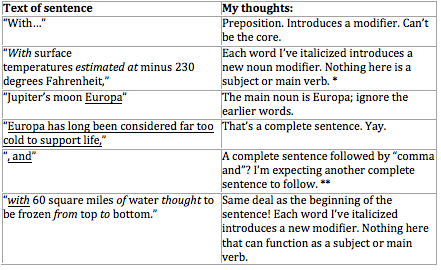-
Target Test Prep 20% Off Flash Sale is on! Code: FLASH20
Redeem
GMAT Sentence Correction: How To Find the Core Sentence - Part 1
 Recently, I was discussing sentence structure with one of my classes and we practiced a crucial but difficult GMAT skill: how to strip an SC sentence to its core components. Multiple OG problems can be solved just by eliminating faulty sentence coresand the real GMAT is testing this skill today more than we see in the published materials.
Recently, I was discussing sentence structure with one of my classes and we practiced a crucial but difficult GMAT skill: how to strip an SC sentence to its core components. Multiple OG problems can be solved just by eliminating faulty sentence coresand the real GMAT is testing this skill today more than we see in the published materials.
So Im going to write a series of articles on just this topic; welcome to part 1 (and props to my Wednesday evening GMAT Fall AA class for inspiring this series!).
Try out this GMATPrep problem from the free exams. (Note: in the solution, Im going to discuss aspects of our SC Process; if you havent learned it already, go read about it right now, then come back and try this problem.)
* With surface temperatures estimated at minus 230 degrees Fahrenheit, Jupiters moon Europa has long been considered far too cold to support life, and with 60 square miles of water thought to be frozen from top to bottom.(A) Europa has long been considered far too cold to support life, and with
(B) Europa has long been considered far too cold to support life, its
(C) Europa has long been considered as far too cold to support life and has
(D) Europa, long considered as far too cold to support life, and its
(E) Europa, long considered to be far too cold to support life, and to have
The First Glance does help on this one, but only if you have studied sentence structure explicitly. Before I did so, I used to think: Oh, they started with Europa because they added a comma in some answers, but that doesnt really tell me anything.
But Ive learned better! What is that comma replacing? Check it out: the first three answers all have a verb following Europa. The final two dont; that is, the verb disappears. That immediately makes me suspect sentence structure, because a sentence does have to have a verb. If you remove a main verb from one location, you have to put one in somewhere else. Ill be watching out for that when I read the sentence.
And now its time to do just that. As I read the sentence, I strip it down to what we call the sentence core in my mind. It took me a long time to develop this skill. Ill show you the result, first, and then Ill tell you how I learned to do it.
The sentence core refers to the stuff that has to be there in order to have a complete sentence. Everything else is extra: it may be important later, but right now, Im ignoring it.
I greyed out the portions that are not part of the core. How does the sentence look to you?
Notice something weird: I didnt just strip it down to a completely correct sentence. Theres something wrong with the core. In other words, the goal is not to create a correct sentence; rather, youre using certain rules to strip to the core even when that core is incorrect.
Using this skill requires you to develop two abilities: the ability to tell what is core vs. extra and the ability to keep things that are wrong, despite the fact that theyll make your core sound funny. The core of the sentence above is:
Europa has long been considered too cold to support life, and.
Clearly, thats not a good sentence! So why did I strip out what I stripped out, and yet leave that comma and in there? Here was my thought process:
* Why isnt estimated a verb?
Estimated is a past participle and can be part of a verb form, but you cant say Temperatures estimated at minus 230 degrees Fahrenheit. Youd have to say Temperatures are estimated at (Note: you could say She estimated her commute to be 45 minutes from door to door. In other words, estimated by itself can be the main verb of a sentence. In my example, though, the subject is actually doing the estimating. In the GMATPrep problem above, the temperatures cant estimate anything!)
** Why is it that I expected another complete sentence to follow the comma and?
The word and is a parallelism marker; it signals that two parts of the sentence need to be made parallel. When you have one complete sentence, and you follow that with comma and, you need to set up another complete sentence to be parallel to that first complete sentence.
For example:
She studied all day, and she went to dinner with friends that night.
The portion before the and is a complete sentence, as is the portion after the and.
(Note: the word and can connect other things besides two complete sentences. It can connect other segments of a sentence as well, such as: She likes to eat pizza, pasta, and steak. In this case, although there is a comma and in the sentence, the part before the comma is not a complete sentence by itself. Rather, it is the start of a list.)
Okay, so my core is:
Europa has long been considered too cold to support life, and.
And thats incorrect. Eliminate answer (A). Either that and needs to go away or, if it stays, I need to have a second complete sentence. Since you know the sentence core is at issue here, check the cores using the other answer choices:
Here are the cores written out:
(B) Europa has long been considered too cold to support life.(C) Europa has long been considered as too cold to support life and has 60 square miles of water.
(D) Europa and its 60 square miles of water.
(E) Europa.
(On the real test, you wouldnt have time to write that out, but you may want to in practice in order to build expertise with this technique.)
Answers (D) and (E) dont even have main verbs! Eliminate both. Answers (B) and (C) both contain complete sentences, but theres something else wrong with one of them. Did you spot it?
The correct idiom is consider X Y: I consider her intelligent. There are some rare circumstances in which you can use consider as, but on the GMAT, go with consider X Y. Answers (C), (D), and (E) all use incorrect forms of the idiom.
Answer (C) also loses some meaning. The second piece of information, about the water, is meant to emphasize the fact that the moon is very cold. When you separate the two pieces of information with an and, however, they appear to be unrelated (except that they're both facts about Europa): the moon is too cold to support life and, by the way, it also has a lot of frozen water. Still, that's something of a judgment call; the idiom is definitive.
The correct answer is (B).
Go get some practice with this and join me next time, when well try another GMATPrep problem and talk about some additional aspects of this technique.
Key Takeaways: Strip the sentence to the Core
(1) Generally, this is a process of elimination: youre removing the things that cannot be part of the core sentence. With rare exceptions, prepositional phrases typically arent part of the core. I left the prepositional phrase of water in answers (C) and (D) because 60 square miles by itself doesnt make any sense. In any case, prepositional phrases never contain the subject of the sentence.
(2) Other non-core-sentence clues: phrases or clauses set off by two commas, relative pronouns such as which and who, comma + -ed or comma + ing modifiers, -ed or ing words that cannot function as the main verb (try them in a simple sentence with the same subject from the SC problem, as I did with temperatures estimated)
(3) A complete sentence on the GMAT must have a subject and a working verb, at a minimum. You may have multiple subjects or working verbs. You could also have two complete sentences connected by a comma and conjunction (such as comma and) or a semi-colon. Well talk about some additional sentence structures later in this series.
* GMATPrep questions courtesy of the Graduate Management Admissions Council. Usage of this question does not imply endorsement by GMAC.
Recent Articles
Archive
- April 2024
- March 2024
- February 2024
- January 2024
- December 2023
- November 2023
- October 2023
- September 2023
- July 2023
- June 2023
- May 2023
- April 2023
- March 2023
- February 2023
- January 2023
- December 2022
- November 2022
- October 2022
- September 2022
- August 2022
- July 2022
- June 2022
- May 2022
- April 2022
- March 2022
- February 2022
- January 2022
- December 2021
- November 2021
- October 2021
- September 2021
- August 2021
- July 2021
- June 2021
- May 2021
- April 2021
- March 2021
- February 2021
- January 2021
- December 2020
- November 2020
- October 2020
- September 2020
- August 2020
- July 2020
- June 2020
- May 2020
- April 2020
- March 2020
- February 2020
- January 2020
- December 2019
- November 2019
- October 2019
- September 2019
- August 2019
- July 2019
- June 2019
- May 2019
- April 2019
- March 2019
- February 2019
- January 2019
- December 2018
- November 2018
- October 2018
- September 2018
- August 2018
- July 2018
- June 2018
- May 2018
- April 2018
- March 2018
- February 2018
- January 2018
- December 2017
- November 2017
- October 2017
- September 2017
- August 2017
- July 2017
- June 2017
- May 2017
- April 2017
- March 2017
- February 2017
- January 2017
- December 2016
- November 2016
- October 2016
- September 2016
- August 2016
- July 2016
- June 2016
- May 2016
- April 2016
- March 2016
- February 2016
- January 2016
- December 2015
- November 2015
- October 2015
- September 2015
- August 2015
- July 2015
- June 2015
- May 2015
- April 2015
- March 2015
- February 2015
- January 2015
- December 2014
- November 2014
- October 2014
- September 2014
- August 2014
- July 2014
- June 2014
- May 2014
- April 2014
- March 2014
- February 2014
- January 2014
- December 2013
- November 2013
- October 2013
- September 2013
- August 2013
- July 2013
- June 2013
- May 2013
- April 2013
- March 2013
- February 2013
- January 2013
- December 2012
- November 2012
- October 2012
- September 2012
- August 2012
- July 2012
- June 2012
- May 2012
- April 2012
- March 2012
- February 2012
- January 2012
- December 2011
- November 2011
- October 2011
- September 2011
- August 2011
- July 2011
- June 2011
- May 2011
- April 2011
- March 2011
- February 2011
- January 2011
- December 2010
- November 2010
- October 2010
- September 2010
- August 2010
- July 2010
- June 2010
- May 2010
- April 2010
- March 2010
- February 2010
- January 2010
- December 2009
- November 2009
- October 2009
- September 2009
- August 2009


